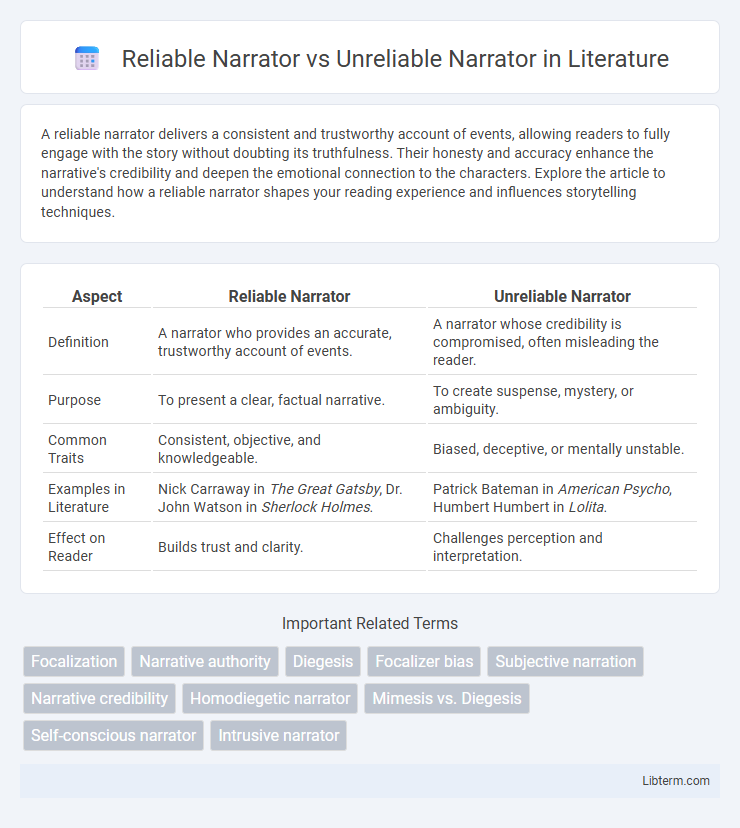A reliable narrator delivers a consistent and trustworthy account of events, allowing readers to fully engage with the story without doubting its truthfulness. Their honesty and accuracy enhance the narrative's credibility and deepen the emotional connection to the characters. Explore the article to understand how a reliable narrator shapes your reading experience and influences storytelling techniques.
Table of Comparison
| Aspect | Reliable Narrator | Unreliable Narrator |
|---|---|---|
| Definition | A narrator who provides an accurate, trustworthy account of events. | A narrator whose credibility is compromised, often misleading the reader. |
| Purpose | To present a clear, factual narrative. | To create suspense, mystery, or ambiguity. |
| Common Traits | Consistent, objective, and knowledgeable. | Biased, deceptive, or mentally unstable. |
| Examples in Literature | Nick Carraway in The Great Gatsby, Dr. John Watson in Sherlock Holmes. | Patrick Bateman in American Psycho, Humbert Humbert in Lolita. |
| Effect on Reader | Builds trust and clarity. | Challenges perception and interpretation. |
Defining the Reliable Narrator
A reliable narrator presents a consistent and trustworthy account of events, providing accurate information aligned with the story's reality. This narrator maintains credibility through clear knowledge, unbiased perspective, and logical coherence in narration. Readers depend on a reliable narrator to interpret plot and character motivations without deception or distortion.
Understanding the Unreliable Narrator
Understanding the unreliable narrator involves recognizing discrepancies between their perspective and objective reality, often revealed through contradictions, biased language, or gaps in the story. Their narratives challenge readers to question the truth, encouraging critical analysis of the plot and character motivations. Techniques such as inconsistent memory, limited knowledge, or intentional deception highlight the unreliability and deepen narrative complexity.
Key Differences Between Reliable and Unreliable Narrators
A reliable narrator provides accurate, consistent, and trustworthy information, enabling readers to understand the true events and characters in a story. In contrast, an unreliable narrator presents distorted, biased, or incomplete information, often leading to confusion or requiring readers to question the narrative's validity. Key differences include the narrator's credibility, perspective accuracy, and the impact on readers' perception of the plot and characters.
Literary Functions of Narrator Reliability
Reliable narrators provide consistent and accurate accounts, establishing trust and guiding readers through the narrative with clarity and coherence. Unreliable narrators create ambiguity and challenge readers to question the truth, enriching the story's depth by introducing multiple interpretations and psychological complexity. The literary function of narrator reliability lies in shaping reader engagement, influencing thematic development, and controlling narrative perspective to enhance plot dynamics.
Techniques for Identifying Narrator Bias
Techniques for identifying narrator bias include analyzing inconsistencies in the narrator's account, detecting contradictions between their perspective and other characters' viewpoints, and examining the narrator's emotional language or selective omission of details. A reliable narrator typically provides coherent, consistent information supported by evidence within the story, whereas an unreliable narrator often reveals subjective judgments, memory distortions, or intentional deception. Close reading of narrative gaps, tone shifts, and perspective distortions helps readers discern the degree of narrator reliability and biases affecting the storytelling.
Impact of Narrator Reliability on Reader Perception
Narrator reliability significantly shapes reader perception by influencing trust and engagement with the story. A reliable narrator provides consistent and truthful accounts, fostering a clear understanding of plot and character intentions. In contrast, an unreliable narrator creates ambiguity and tension, prompting readers to question the narrative and actively interpret underlying motives and hidden meanings.
Famous Examples of Reliable Narrators
Famous examples of reliable narrators include Atticus Finch in Harper Lee's "To Kill a Mockingbird," whose moral clarity and honesty guide readers through the complexities of racial injustice. Another notable reliable narrator is Dr. John Watson from Arthur Conan Doyle's Sherlock Holmes series, offering factual and consistent accounts that support Holmes's deductive reasoning. These narrators enhance trust and credibility, allowing readers to engage confidently with the narrative's perspective.
Memorable Unreliable Narrators in Literature
Memorable unreliable narrators like Humbert Humbert in Vladimir Nabokov's "Lolita" and Patrick Bateman in Bret Easton Ellis's "American Psycho" challenge readers' trust through distorted perceptions and biased storytelling. Their narratives create complex layers of meaning by blending subjective truths with deception, compelling critical analysis of the text's reliability. This narrative technique deepens engagement and adds psychological depth, making unreliable narrators powerful tools in literary storytelling.
Why Authors Choose Unreliable Narrators
Authors choose unreliable narrators to create suspense and engage readers in active interpretation, challenging them to discern the truth within a biased or distorted perspective. This technique deepens character complexity and explores themes of perception, memory, and reality. By using unreliable narration, writers blur the line between truth and deception, enriching the narrative's psychological and emotional layers.
Crafting Effective Narrators in Your Own Writing
Crafting effective narrators involves distinguishing between reliable and unreliable perspectives to shape readers' engagement and interpretation. Reliable narrators provide consistent, trustworthy accounts that build credibility, while unreliable narrators introduce ambiguity and complexity, challenging readers to discern truth from deception. Writers enhance storytelling by carefully controlling narrator reliability to manipulate narrative tension and deepen character development.
Reliable Narrator Infographic

 libterm.com
libterm.com